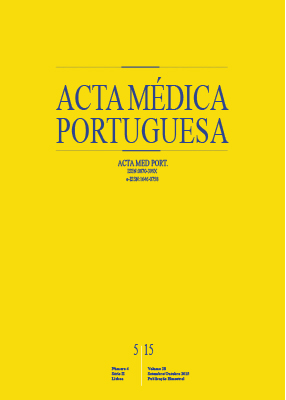Neonatal Morbidity in Term Newborns Born by Elective Cesarean Section
DOI:
https://doi.org/10.20344/amp.5878Keywords:
Cesarean Section, Elective Surgical Procedures, Infant, Newborn, Term Birth.Abstract
Introduction: International guidelines suggest that non-urgent planned deliveries be scheduled at or after 39 weeks. Despite this recommendation elective cesarean often occurs before 39 weeks. Some research has demonstrated that elective cesarean before 39 weeks poses a greater risk to the infants than at or after 39 weeks.Objective: To evaluate neonatal morbidity in term newborns born by elective cesarean section.
Material and Methods: Retrospective study of all term elective cesarean sections (scheduled and without labor) performed in level III maternity, in the last 11 years (2003 - 2013). High risk pregnancies were excluded: twins, premature rupture of membranes, preeclampsia, poorly controlled diabetes mellitus, Rh isoimmunization and congenital malformations. Two groups of newborns with gestational age less than 39 weeks and equal or greater than 39 weeks gestational age were compared.
Results: In our sample, 45% of elective caesarean sections were performed before 39 weeks. Infants born before 39 weeks were more frequently admitted in neonatal intensive care, odds ratio 2.4 [1.4 – 4.1] p = 0.001, had more respiratory morbidity, odds ratio 2.4 [1.6 - 3.8] p < 0.001, more hyperbilirubinaemia odds ratio 2.3 [1.5 – 3.7] p < 0.001, more hypoglycaemia and/or feeding difficulties odds ratio 1.6 [1.2 – 2.4] p = 0.006, and longer admissions (more than five days), odds ratio 2.0 [1.4 - 3] p < 0.001.
Discussion: As in other studies ‘early term’ had higher respiratory and metabolic morbidity and consequently had a longer hospital stay.
Conclusion: These findings support recommendations to delay elective cesarean delay until 39 weeks of gestation.
Downloads
Downloads
Published
How to Cite
Issue
Section
License
All the articles published in the AMP are open access and comply with the requirements of funding agencies or academic institutions. The AMP is governed by the terms of the Creative Commons ‘Attribution – Non-Commercial Use - (CC-BY-NC)’ license, regarding the use by third parties.
It is the author’s responsibility to obtain approval for the reproduction of figures, tables, etc. from other publications.
Upon acceptance of an article for publication, the authors will be asked to complete the ICMJE “Copyright Liability and Copyright Sharing Statement “(http://www.actamedicaportuguesa.com/info/AMP-NormasPublicacao.pdf) and the “Declaration of Potential Conflicts of Interest” (http:// www.icmje.org/conflicts-of-interest). An e-mail will be sent to the corresponding author to acknowledge receipt of the manuscript.
After publication, the authors are authorised to make their articles available in repositories of their institutions of origin, as long as they always mention where they were published and according to the Creative Commons license.









